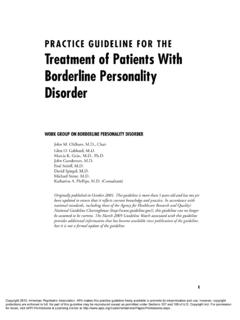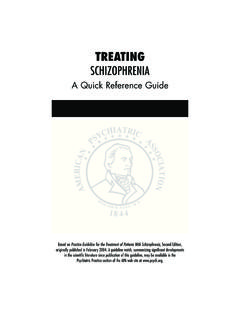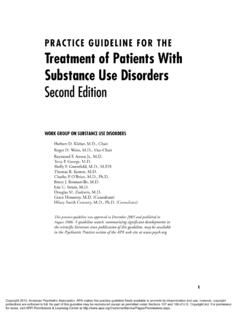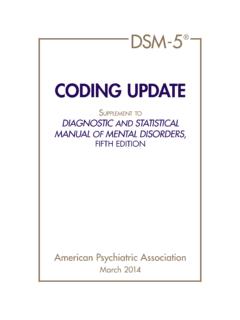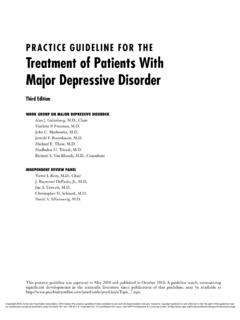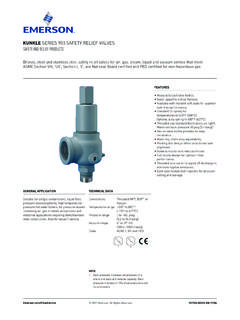Transcription of SUICIDAL BEHAVIORS - Psychiatry
1 ASSESSING AND TREATING. SUICIDAL BEHAVIORS . A Quick Reference Guide Based on Practice Guideline for the Assessment and Treatment of Patients With SUICIDAL BEHAVIORS , originally published in November 2003. A guideline watch, summarizing significant developments in the scientific literature since publication of this guideline, may be available in the Psychiatric Practice section of the APA web site at American Psychiatric Association Steering Committee on Practice Guidelines John S. McIntyre, , Chair Sara C. Charles, , Vice-Chair Daniel J. Anzia, Ian A. Cook, Molly T. Finnerty, Bradley R. Johnson, James E. Nininger, Paul Summergrad, Sherwyn M. Woods, , Joel Yager, Area and Component Liaisons Robert Pyles, (Area I). C. Deborah Cross, (Area II). Roger Peele, (Area III). Daniel J. Anzia, (Area IV). John P. D. Shemo, (Area V). Lawrence Lurie, (Area VI). R. Dale Walker, (Area VII). Mary Ann Barnovitz, Sheila Hafter Gray, Sunil Saxena, Tina Tonnu, Medical Editors, Quick Reference Guides Michael B.
2 First, Laura J. Fochtmann, Staff Robert kunkle , , Senior Program Manager Amy B. Albert, , Assistant Project Manager Claudia Hart, Director, Department of Quality Improvement and Psychiatric Services Darrel A. Regier, , , Director, Division of Research Statement of Intent The Practice Guidelines and the Quick Reference Guides are not intended to be construed or to serve as a standard of medical care. Standards of medical care are determined on the basis of all clinical data available for an individual patient and are subject to change as scientific knowledge and technology advance and practice patterns evolve. These parameters of practice should be considered guidelines only. Adherence to them will not ensure a successful outcome for every individual, nor should they be interpreted as including all proper methods of care or excluding other acceptable methods of care aimed at the same results. The ultimate judg- ment regarding a particular clinical procedure or treatment plan must be made by the psychiatrist in light of the clinical data presented by the patient and the diag- nostic and treatment options available.
3 The development of the APA Practice Guidelines and Quick Reference Guides has not been financially supported by any commercial organization. For more detail, see APA's Practice Guideline Development Process, available as an appen- dix to the compendium of APA practice guidelines, published by APPI, and online at 278 ASSESSING AND TREATING SUICIDAL BEHAVIORS . OUTLINE. A. Assessment of B. Psychiatric Patients With Management SUICIDAL BEHAVIORS 1. Establish and maintain 1. Conduct a a therapeutic thorough psychiatric alliance ..287. evaluation ..279 2. Attend to the 2. Specifically inquire patient's about SUICIDAL 3. Determine a thoughts, plans, treatment setting ..288. and BEHAVIORS ..281 4. Develop a plan of 3. Establish a multiaxial diagnosis ..284 5. Coordinate care and 4. Estimate suicide collaborate with other clinicians ..292. 6. Promote adherence to the treatment plan ..292. C. Specific Treatment 7.
4 Provide education Modalities to the patient and 1. Somatic family ..292. Therapies ..294 8. Reassess safety 2. Psychotherapies ..295 and suicide risk ..293. 9. Monitor psychiatric status and response D. Documentation and to treatment ..293. Risk Management 10. Obtain consultation, 1. General Issues if Specific to Suicide ..295. 2. Suicide Prevention Contracts ..295. 3. Communication With Significant Others ..297. 4. Management of Suicide in One's Practice ..297. 5. Mental Health Interventions for Surviving Family and Friends After a Suicide ..297. ASSESSING AND TREATING SUICIDAL BEHAVIORS 279. A. Assessment of Patients With SUICIDAL BEHAVIORS Refer to Table 1, p. 281, for circumstances in which suicide assessment may be indicated. 1. Conduct a thorough psychiatric evaluation. Identify psychiatric signs and symptoms. Determine the presence or absence of signs and symptoms associated with specific psychiatric diagnoses.
5 Identify specific psychiatric symptoms that may influence suicide risk, including aggression, violence toward others, impulsiveness, hopelessness, agitation, psychic anxiety, anhedonia, global insomnia, and panic attacks. Assess past SUICIDAL behavior, including intent of self-injurious acts. For each attempt, obtain details about the precipitants, timing, intent, consequences, and medical severity. Ascertain if alcohol and drugs were consumed before the attempt. Delineate interpersonal aspects of the attempt in order to understand issues that culminated in the attempt ( , persons present at the time of the attempt or to whom the attempt was communicated). Determine the patient's thoughts about the attempt ( , perception of potential for lethality, ambivalence toward living, visualization of death, degree of premeditation, persistence of SUICIDAL ideation, and reaction to the attempt). Review past treatment history and treatment relationships.
6 Review psychiatric history ( , previous and comorbid diagnoses, prior hospitalizations and other treatment, past SUICIDAL ideation). Review history of medical treatment ( , identify medically serious suicide attempts and past or current medical diagnoses). Gauge the strength and stability of current and past therapeutic relationships. 280 ASSESSING AND TREATING SUICIDAL BEHAVIORS . 1. Conduct a thorough psychiatric evaluation (continued). Identify family history of suicide, mental illness, and dysfunction. Inquire about family history of suicide and suicide attempts and psychiatric hospitalizations or mental illness, including substance use disorders. Determine the circumstances of suicides in first-degree relatives, including the patient's involvement and the patient's and relative's ages at the time. Determine childhood and current family milieu, including history of family conflict or separation, parental legal trouble, family substance use, domestic violence, and physical and/or sexual abuse.
7 Identify current psychosocial situation and nature of crisis. Consider acute psychosocial crises or chronic psychosocial stressors that may augment suicide risk ( , financial or legal difficulties;. interpersonal conflicts or losses; stressors in gay, lesbian, or bisexual youths; housing problems; job loss; educational failure). Appreciate psychological strengths and vulnerabilities of the individual patient. Consider how coping skills, personality traits, thinking style, and developmental and psychological needs may affect the patients'. suicide risk and the formulation of the treatment plan. ASSESSING AND TREATING SUICIDAL BEHAVIORS 281. TABLE 1. Circumstances in Which a Suicide Assessment May Be Indicated Clinically Emergency department or crisis evaluation Intake evaluation (on either an inpatient or an outpatient basis). Before a change in observation status or treatment setting ( , discontinuation of one-to-one observation, discharge from inpatient setting).
8 Abrupt change in clinical presentation (either precipitous worsening or sudden, dramatic improvement). Lack of improvement or gradual worsening despite treatment Anticipation or experience of a significant interpersonal loss or psychosocial stressor ( , divorce, financial loss, legal problems, personal shame or humiliation). Onset of a physical illness (particularly if life threatening, disfiguring, or associated with severe pain or loss of executive functioning). 2. Specifically inquire about SUICIDAL thoughts, plans, and BEHAVIORS . Refer to Table 2, p. 283, for specific issues to address. Elicit the presence or absence of SUICIDAL ideation. Address the patient's feelings about living with questions such as How does life seem to you at this point? or Have you ever felt that life was not worth living? or Did you ever wish you could go to sleep and just not wake up? . Focus on the nature, frequency, extent, and timing of SUICIDAL thoughts, and consider their interpersonal, situational, and symptomatic context.
9 Speak with family members or friends to determine whether they have observed behavior ( , recent purchase of a gun) or have been privy to thoughts that suggest SUICIDAL ideation. If the patient is intoxicated with alcohol or other substances when initially interviewed, the patient's suicidality will need to be reassessed at a later time. 282 ASSESSING AND TREATING SUICIDAL BEHAVIORS . 2. Specifically inquire about SUICIDAL thoughts, plans, and BEHAVIORS (continued). Elicit the presence or absence of a suicide plan. Probe for detailed information about specific plans for suicide and any steps that have been taken toward enacting those plans. Determine the patient's belief about the lethality of the method, which may be as important as the actual lethality of the method. Determine the conditions under which the patient would consider suicide ( , divorce, going to jail, housing loss) and estimate the likelihood that such a plan will be formed or acted on in the near future.
10 Inquire about the presence of a firearm in the home or workplace. If a firearm is present, discuss with the patient or a significant other the importance of restricting access to, securing, or removing this and other weapons. Assess the patient's degree of suicidality, including SUICIDAL intent and lethality of plan. Determine motivation for suicide, seriousness and extent of the patient's aim to die, associated BEHAVIORS or planning for suicide, and lethality of the method. Recognize that suicide assessment scales have very low predictive values and do not provide reliable estimates of suicide risk. Nonetheless, they may be useful in developing a thorough line of questioning about suicide or in opening communication with the patient. ASSESSING AND TREATING SUICIDAL BEHAVIORS 283. TABLE 2. Questions That May Be Helpful in Inquiring About Specific Aspects of SUICIDAL Thoughts, Plans, and BEHAVIORS Begin with questions that address the patient's feelings about living: Have you ever felt that life was not worth living?



